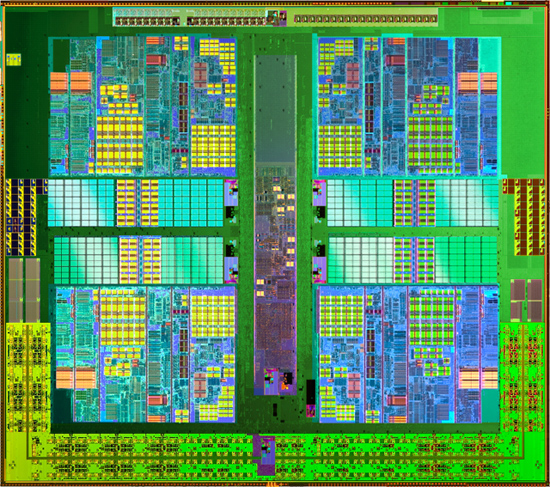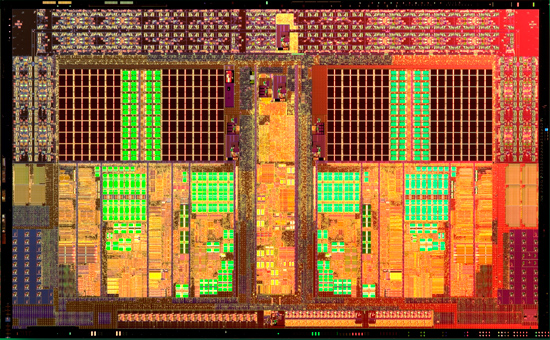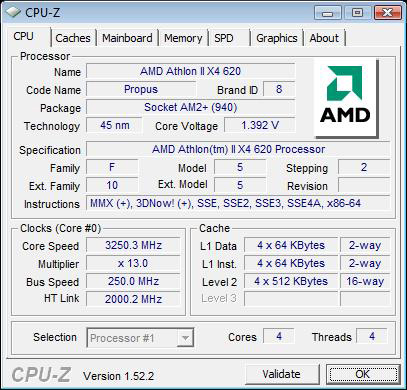AMD Athlon II X4 620 & 630: The First $99 Quad Core CPU
by Anand Lal Shimpi on September 16, 2009 12:00 AM EST- Posted in
- CPUs
How does AMD respond to Lynnfield? Is it by drastically cutting prices on Phenom II? Nope. By introducing the world’s first quad-core processor to debut at $99. Now that’s cool.

It’s called the Athlon II X4 and its existence shouldn’t be any surprise. AMD quietly announced it along with the Athlon II X2 line.

Today we get two models: the Athlon II X4 630 and the Athlon II X4 620, priced at $122 and $99 respectively. The only difference between the two is clock speed; the 630 runs at 2.8GHz while the 620 runs at 2.6GHz. These are both AM3 chips meaning they'll work in AM3 motherboards with DDR3 memory or AM2+ boards with DDR2 memory.
| Processor | Clock Speed | L2 Cache | L3 Cache | TDP | Price |
| AMD Phenom II X4 965 BE | 3.4GHz | 2MB | 6MB | 140W | $245 |
| AMD Phenom II X4 955 BE | 3.2GHz | 2MB | 6MB | 125W | $245 |
| AMD Phenom II X4 945 | 3.0GHz | 2MB | 6MB | 125W | $225 |
| AMD Phenom II X3 720 BE | 2.8GHz | 1.5MB | 6MB | 95W | $145 |
| AMD Phenom II X2 550 BE | 3.1GHz | 1MB | 6MB | 80W | $105 |
| AMD Athlon II X4 630 | 2.8GHz | 2MB | 0MB | 95W | $122 |
| AMD Athlon II X4 620 | 2.6GHz | 2MB | 0MB | 95W | $99 |
| AMD Athlon II X2 250 | 3.0GHz | 2MB | 0MB | 65W | $87 |

This isn’t a harvested Phenom II nor is it a pair of Athlon II X2s, instead it looks like we have a brand new die on our hands (some Athlon II X4s will be crippled Phenom IIs but AMD insists that the new die will be used). The Athlon II X4 has four cores on a single die, but unlike the Athlon II X2 each core only has a 512KB L2 per core. You can tell by the die shot that the core-to-cache ratio is much higher than on the X2:

The 45nm Athlon II X4 Propus die

The 45nm Athlon II X2 die (note the larger L2 per core)
Like the rest of the Athlon II lineup there is no L3 cache. This helps keep the die small (and affordable) but also hurts performance:
| Processor | SYSMark 2007 Overall | E-Learning | Video Creation | Productivity | 3D |
| AMD Phenom II X4 920 (2.8GHz) | 173 | 151 | 212 | 167 | 167 |
| AMD Athlon II X4 630 (2.8GHz) | 157 | 128 | 221 | 131 | 162 |
| % of Phenom II X4 | 91% | 85% | 104% | 78% | 97% |
At the same clock speed the Athlon II X4 should offer roughly 90% of the performance of a Phenom II X4.
| Processor | Cores | Manufacturing Process | L1 Cache | L2 Cache | L3 Cache | Die Size | Transistor Count |
| AMD Phenom II X4 | 4 | 45nm | 128KB per core | 512KB per core | 6MB | 258 mm2 | 758M |
| AMD Athlon II X4 | 4 | 45nm | 128KB per core | 512KB per core | 0MB | 169 mm2 | 300M |
| AMD Athlon II X2 | 2 | 45nm | 128KB per core | 1MB per core | 0MB | 117 mm2 | 234M |
| Intel Core 2 Quad Q8xxx | 4 | 45nm | 64KB per core | 4MB | 0MB | 164 mm2 | 456M |
The price is unbeatable. If we ignore the 630 for a moment, the Athlon II X4 620 is by far the cheapest route to four cores on the market. Intel’s most affordable quad-core is the Core 2 Quad Q8200 at $163, while AMD would previously charge you $163 for a Phenom X4 9600B. This is where the AM3/AM2+ compatibility play really helps out. Motherboard/memory costs are as cheap as possible thanks to AMD's incredible socket flexibility.

And just in case you’re wondering, yes, the Athlon II X4 620 actually delivers performance competitive with the Q8200 but for 60% of the cost. It’s not all that clear cut, there are some cases where the 620 is faster but others where the Q8200 is much faster. On average it ends up being a wash but you’ll want to pay attention to the coming pages to see how the cookie crumbles as it does vary from test to test.

Codename Propus
Overclocking isn't unfortunately as good as the Phenom IIs; the result of a conscious design decision or simply the early nature of the Propus die. That being said, without a single extra millivolt I was able to hit 3.25GHz on my Athlon II X4 620 sample - making it even more valuable. Extra voltage proved mostly useless, I could only approach 3.4GHz with an extra 300mV.
Let’s see, have I thoroughly ruined the surprise? Check. Now let’s get to the tests.
The Test
| Motherboard: | Intel DX58SO (Intel X58) Intel DX48BT2 (Intel X48) Gigabyte GA-MA790FX-UD5P (AMD 790FX) |
| Chipset: | Intel X48 Intel X58 AMD 790FX |
| Chipset Drivers: | Intel 9.1.1.1015 (Intel) AMD Catalyst 8.12 |
| Hard Disk: | Intel X25-M SSD (80GB) |
| Memory: | Qimonda DDR3-1066 4 x 1GB (7-7-7-20) Corsair DDR3-1333 4 x 1GB (7-7-7-20) Patriot Viper DDR3-1333 2 x 2GB (7-7-7-20) |
| Video Card: | eVGA GeForce GTX 280 |
| Video Drivers: | NVIDIA ForceWare 180.43 (Vista64) NVIDIA ForceWare 178.24 (Vista32) |
| Desktop Resolution: | 1920 x 1200 |
| OS: | Windows Vista Ultimate 32-bit (for SYSMark) Windows Vista Ultimate 64-bit |










150 Comments
View All Comments
thezorro - Wednesday, September 16, 2009 - link
remember that the lynnfield core i7 750 has turbo overclocking enabled so is overclocked to 3.2 ghz, which is 600 mhz overclocking, while amd processors are running at stock speedIs unfair to present the results this way, turbo is overclocking.
Wivvix - Thursday, September 17, 2009 - link
Sorry but your logic fails. It is a feature of the i7 750, that it runs at slower speeds when idle, as to when the processor is under load.In the same way, fan speed RPM is automatically regulated depending on whether the process is idle or under load.
The maximum clock speed of an i7 750 is 3.2gh. The user doesn't have to change or do anything. This is not overclocking in the sense you purport, and is not unfair. That is the maximum clock speed of the processor out of the box. End of story.
kagenokurei - Wednesday, September 16, 2009 - link
im sorry, but i have to defend thezorro at least this time..overclocking's basic principle is to increase CPU speeds..but if u guys look into it, what u increase is the core clock(GHz,MHz,etc) beyond the factory released specs..voltage increases and other tweaks are only done to make the overclock stable..
now,in this light,i also find it quite unfair to compare the single threaded performance of the i7s with the PII X4s..simply because the i7s can run its single core at a higher clock when the others are idle..therefore,overclocking at least THAT core..w/c of course, the PII X4s are unable to do..
i agree that the Turbo mode is a good feature, and AMD should have something like it on their CPUs..until then, the Turbo mode is kind of an unfair advantage in benchmarking single threaded performance..
jonup - Wednesday, September 16, 2009 - link
Well the PII 965 is an overclocked to 3.4GHz, which is 600MHz overclocking of 920. It's unfair to present the results this way. The 965BE is so obviously OCed because it uses tons more power than the 920.fitten - Wednesday, September 16, 2009 - link
Bzzzt... wrong... when will you fanbois give this up? It's the normal and default behavior of the thing. You can do the academic discussion all you want but normal operation of the chips has Turbo enabled. To test any other way is to test a non-standard, non-default operating mode. You might as well test with the caches disabled or one or more cores disabled since those are all non-standard, non-default operating modes as well.maxxcool - Wednesday, September 16, 2009 - link
++ ding!Archangel59 - Wednesday, September 16, 2009 - link
I can see both sides of this where Turbo could be considered altering the "normal" operation and also where turbo could be considered just the way it works.Doesnt bother me either way that this is put in the article, still good news from AMD.
However, since the turbo mode could be considered a supplied feature of the chip... couldnt the use of AMD Overdrive be considered a supplied feature of the newer chips? Even if it couldnt, I'd still love to see an article comparing the turbo mode to a well set up AMD Overdrive profile.
Lunyone - Wednesday, September 16, 2009 - link
So what your saying is that the test are fair because AMD doesn't have this "turbo" mode, so all of the benchmarks are created equal?? So if the benchmarks had set up the 955/965 to 3.2 gHz (with unlocked multiplier) than you would have a favorable review??Lunyone - Wednesday, September 16, 2009 - link
Crap! I meant to say "aren't fair" in a couple of lines in my response :(SlyNine - Wednesday, September 16, 2009 - link
Turbo mode is not overclocking. Overclocking is clocking OVER factor speeds.If the CPU can increase the speed as a factory set speed. THAT IS NOT OVERCLOCKING, so get over it.
On the other hand. Go AMD. I'm still awaiting the big Core I7 killer. comon AMD you can do it.